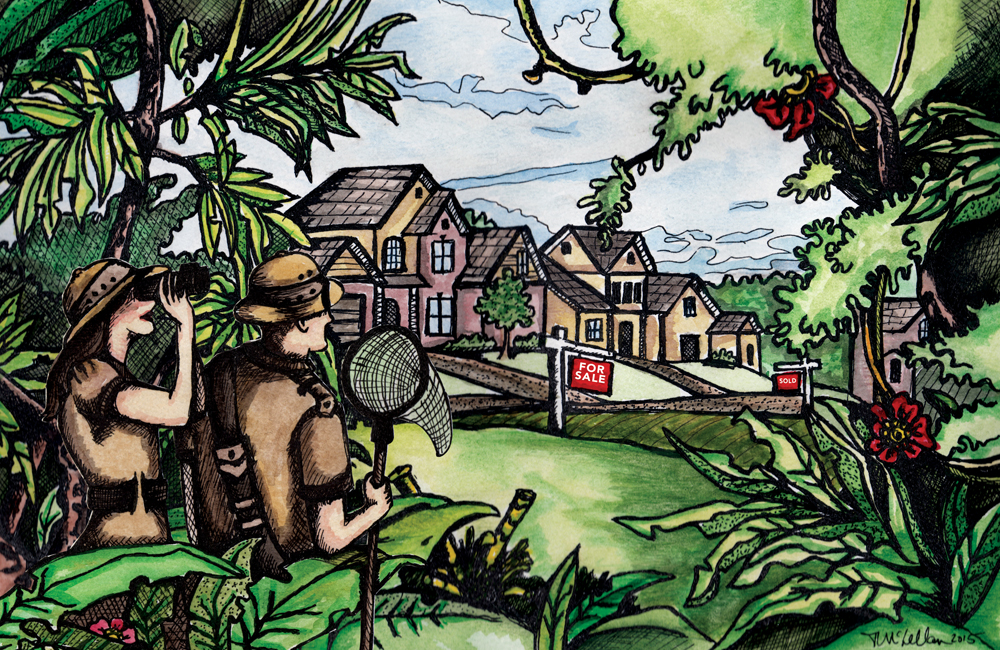12 things to consider before taking the leap
story by Janet Lees ❧ illustration by Robert Carter
You’ve just heard another story about someone making a fortune on a real estate investment. Should you get into the market?
With the Canadian dollar falling and the stock market fluctuating, more and more people are choosing to add real estate to their investment portfolios, says Tara Parsons, a sales representative with Royal LePage Trinity Realty in Collingwood. Parsons has helped dozens of clients make the move into buying real estate as an investment, and she has personally been investing in properties for over 30 years.
“It’s a big part of our market,” says Parsons. “The stock market has been very volatile, and interest rates are at a historic low, so people are looking to diversify their portfolios, and what better way to do it than buying property that may eventually fulfill their retirement needs. In the meantime lease it to tenants who cover the carrying costs. Another key aspect playing a significant role is that as our dollar has slid considerably compared to the U.S., some who purchased in 2008-2013 in Arizona or Florida may be weighing the viability of keeping those homes or offloading them so they can use that money in Canada.”
Now that we’re in a seller’s market, prices are increasing, but that doesn’t mean real estate is less of a worthwhile investment, adds Parsons. She says diversifying your portfolio with real estate when you are over 40 makes sense to better balance your income stream into retirement, adding our local market makes for a strong investment case due to the influx of Zoomers from the GTA.
“I assisted multiple couples looking to invest in bungalows in town because there was a sense of where the market was heading. A typical purchase was $269,000 to $289,000 in 2014. In today’s market the same home is selling for $340,000,” notes Parsons. “Currently an in-town brick bungalow is selling for $300,000-plus with multiple competing offers – but it is worth it. Buy the right one and invest, for example, $10,000 into improvements and you may have increased your equity to $340,000, and in the meantime lease it for $1,600 a month plus utilities, with little worry of finding good tenants and watch it appreciate.”
Buying investment property is all about return on investment – having the property pay for itself while increasing its value over time. Knowing what types of properties will give you the best return on your investment is key. One of Parsons’ clients purchased a bungalow in 2005 for $234,000 with a $60,000 down payment. The tenants’ rent covered the monthly costs with a small monthly profit. Over the five years they owned the home, the tenants paid down the mortgage by $30,000. The owner then invested $30,000 in improvements and sold it for $340,000 – for a total profit of $106,000 after five years.
“There’s a formula I use for properties when advising clients,” says Parsons. “It has to hit a certain price point, brick bungalow works best, preferrably with a garage, on a town lot, and ideally own it for at least five years … you have to have parameters because you want it to be as liquid as possible.”
She adds that television shows in which people buy a home, renovate it in the course of an hour-long show and greatly increase its value are also having an impact. “There are many more people jumping into the market than even five years ago. This whole investment market segment has emerged in a big way largely due to TV.”
However, a real estate investment is not something to be entered into lightly. It’s important to know what your parameters and your capabilities are. Below is the checklist Parsons uses herself and shares with clients who are looking to make a real estate investment purchase.
1. What length of time is ideal for your investment?
Is it a five-year plan? If so, forecast what investment will be required over the term for maintenance and improvements as well as what you might need to spend in the end in order to resell (e.g. painting, windows and carpet).
2. Are you interested in commercial or residential real estate?
These are two very different markets and require different skill sets. How stable are each of these markets in your target area?
In a smaller market, downtown commercial is often substantially impacted by the introduction of big-box retailers traditionally located on the fringe of a town. Also, the way commercial properties are valued is very different than residential properties, as are the costs and financing options.
Those interested in residential real estate investing need to consider factors such as the neighbourhood/location, comparable property prices, financing options, the investment property purchase and sale process, and finding residential tenants.
3. What area or location specifics are important?
What is the best location for the demographic that you are targeting for lease and for resale? Evaluate properties based on return on investment.
In addition to the building and property, there are often crucial factors that are vital. For example, proximity to downtown, walkability score, library, restaurants and lifestyle considerations.
4. What is the current and future viability of leasing opportunities?
Who is the ideal tenant and what is the demographic? How do you attract them? What qualities are most important to maximize the income and care of the property?
Ask and answer the simple questions: does it need to have a garage or main floor master bedroom? How many bedrooms? Is your target demo 50-plus or family? Recreational or professional?
5. What is your construction, structural and maintenance knowledge?
Are you familiar with fire and safety building codes? Are construction and maintenance in your realm of expertise, or are you hiring professionals? If it’s the latter, this will impact your profitability. Monitor any improvements closely and do not over-improve.
6. What are your desired non-negotiables?
Do you want brick exterior structure, or are you okay with siding? Townhouse or detached? Bungalow or multi-storey? What about the furnace? Air conditioning? Newer roof and/or windows? Or could these be replaced at the onset of purchase or between tenants or at resale? Ideally, build in staggered expenses to offset income.
7. What are the associated costs?
These include taxes, insurance, mortgage, closing costs and potential repairs. Come up with a best and worst case scenario for each cost.
Have you calculated a formula that illustrates the best return on your investment? For example, if you want to invest in a brick bungalow in downtown Collingwood, figure out your maximum purchase price and your downpayment amount.
Who will manage the property? Do you have the ability to set aside a contingency fund to handle unexpected expenses?
8. How many properties should you realistically purchase?
You want to diversify your portfolio, but not over-extend your time and attention. Should the strategy be to start small and then stagger subsequent purchases to reflect best-case conditions and cash flow?
9. Be prepared to act quickly.
It may take a year to find the correct property. When you do find it, others will also see it as ideal. Act quickly and decisively! Don’t low-ball your offer; you will loose in a competitive market or worse, end up in a bidding war where the price could rise beyond your acceptable range.
Offer what you think is fair based on your research. It is imperative to enter the process with as few conditions as possible and if a quick closing would benefit the seller, make sure that you can accommodate that.
Obviously, mortgage pre-approval and an inspection prior to making an offer will allow you make an informed decision about conditions to include and exclude.
Arm your agent with enough knowledge of your personal philosophy to negotiate in a multiple offer situation on your behalf.
10. Be selective with whom you choose as a tenant.
The difference between a good tenant and a bad tenant can be the difference between being profitable and loosing money. The offer to lease should be accompanied by a rental application, credit checks and as much background information as you can obtain.
11. Educate yourself on the landlord/tenant act of Ontario.
You need to be aware of your responsibilities and your tenant’s responsibilities and limitations to remedy situations. What if you encounter issues with pets, damage or smoking? Have the lease drawn up by a professional.
12. Know the zoning and bylaws in the neighborhood, and check with the planning department if you plan to renovate or duplex.
Use an experienced and competent real estate professional to guide you, look after your best interests and help you to avoid some of the potential pitfalls. Request that they share their related knowledge and background, as well as their strategy for negotiation.
In order to maximize your return on investment, real estate should be considered a long-term investment to allow for changing market conditions. A short-term flip in our market is risky, notes Parsons. However, if you do your homework and understand the ins and outs of investment properties, real estate investing can pay big dividends both now and in the future.
“I and many of my clients are diversifying our portfolios to ensure into retirement that our portfolios remain strong,” says Parsons, “keeping in the back of our minds future options of downsizing or allowing for travel, in which case living in a bungalow in town could also be an excellent lifestyle strategy down the road.” ❧
Read More about Real Estate in this Issue
– Real Estate Q&A
– The Game Has Changed!
– Sell, Sell, Sell!
– Ready, Set, List!
– Buying Strategies
– The Best Bidder
– Going to the Country?
– Thinking of Investing in Real Estate?













